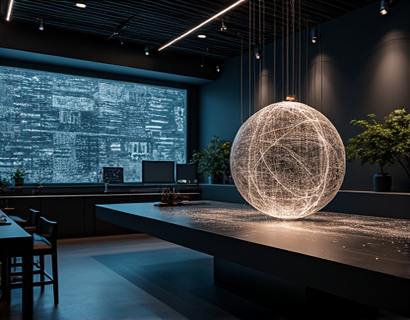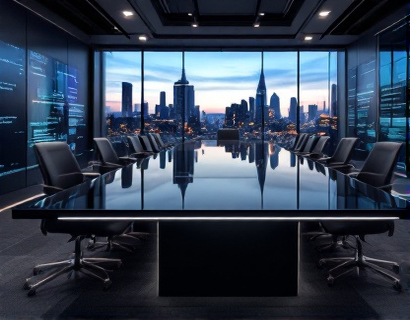Embracing the Future: How Augmented Reality is Revolutionizing E-Commerce and Daily Life
In an era where technology seamlessly integrates into our daily routines, augmented reality (AR) stands out as a transformative force, particularly within the realm of e-commerce. This innovative technology is not just a novelty but a powerful tool that enhances consumer experiences, making shopping more interactive, informative, and enjoyable. By overlaying digital information onto the physical world, AR bridges the gap between online and offline shopping, offering a unique and immersive experience that traditional e-commerce platforms cannot match.
The integration of AR in e-commerce is reshaping how consumers interact with products before making a purchase. Gone are the days of relying solely on images and descriptions. With AR, customers can visualize products in their own environment, gaining a deeper understanding of the item's size, color, and how it fits into their lifestyle. This level of engagement not only boosts customer confidence but also reduces return rates, benefiting both consumers and retailers.
Transforming the Shopping Experience
One of the most significant advantages of AR in e-commerce is its ability to transform the shopping experience. Imagine being able to see how a piece of furniture would look in your living room or how a new piece of clothing would fit without physically trying it on. This capability not only saves time but also enhances the overall shopping journey. Retailers that adopt AR technology can offer a more personalized and interactive experience, setting themselves apart in a competitive market.
For tech-savvy consumers, the allure of AR is undeniable. These individuals are eager to explore and adopt new technologies that make their lives easier and more exciting. By providing an AR-enhanced shopping experience, e-commerce platforms cater to this demographic, offering them a platform where they can experiment with products in a virtual space. This not only increases customer satisfaction but also fosters brand loyalty among early adopters of AR technology.
Enhancing Product Visualization
Product visualization is a critical aspect of online shopping, and AR takes this to a whole new level. Traditional product images and 3D models can only do so much in conveying the true essence of a product. AR, however, allows customers to see products in action, from different angles, and in various scenarios. For instance, a customer looking to buy a new smartphone can use AR to see how the device fits in their hand, examine its features, and even test out different cases and accessories virtually.
This immersive experience is particularly beneficial for complex or high-value items where understanding the product's functionality is crucial. By providing a realistic preview, AR helps consumers make more informed decisions, reducing the likelihood of dissatisfaction post-purchase. Moreover, for products that are difficult to describe or demonstrate through text and images alone, AR offers a solution that enhances the shopping process and builds trust between the consumer and the retailer.
Personalized Shopping with AR
Personalization is a key trend in e-commerce, and AR plays a pivotal role in delivering tailored shopping experiences. By leveraging AR, retailers can offer personalized recommendations based on a customer's preferences and past interactions. For example, an AR app can suggest outfits that complement a user's existing wardrobe or recommend home decor items that match their interior design style.
Furthermore, AR can facilitate virtual try-ons, allowing customers to see how makeup, glasses, or accessories would look on them without the need for physical products. This not only enhances the shopping experience but also caters to individual tastes and preferences, making the shopping process more enjoyable and efficient. As consumers increasingly seek personalized experiences, AR-powered e-commerce platforms are well-positioned to meet these demands.
Case Studies: Successful AR Implementations
Several e-commerce platforms have successfully integrated AR into their offerings, demonstrating the technology's potential to drive engagement and sales. One notable example is an furniture retailer that developed an AR app allowing customers to visualize furniture in their homes before purchasing. The app uses the device's camera to overlay 3D models of furniture in the user's space, providing an accurate scale and perspective. This feature has significantly reduced return rates and increased customer satisfaction, as users feel more confident in their purchasing decisions.
Another example is a fashion brand that introduced an AR try-on feature for its clothing line. Customers can use their smartphones to see how outfits look on them without the need for physical try-ons. This not only streamlines the shopping process but also provides a fun and interactive experience. The brand has reported a notable increase in sales and customer engagement since implementing the AR feature, highlighting the technology's effectiveness in enhancing the shopping journey.
Building Trust Through Transparency
Trust is a fundamental component of any successful e-commerce transaction, and AR helps build this trust by providing transparency. When customers can see and interact with products in a virtual environment, they gain a better understanding of the item's quality and features. This transparency reduces the uncertainty associated with online shopping, where customers often rely on static images and descriptions that may not fully represent the product.
Moreover, AR can be used to showcase product details that might be difficult to convey through traditional means. For instance, a tech gadget manufacturer can use AR to demonstrate the device's features in action, highlighting its capabilities and benefits. This level of detail not only educates the customer but also instills confidence in the product, leading to higher conversion rates and customer loyalty.
The Future of E-Commerce: AR-Driven Innovations
As AR technology continues to evolve, its role in e-commerce is set to expand even further. Future innovations may include more sophisticated AR experiences, such as virtual shopping assistants that guide customers through the purchasing process, augmented product reviews, and interactive customer support. These advancements will not only enhance the shopping experience but also open up new opportunities for retailers to engage with their customers in meaningful ways.
Additionally, the integration of AR with other emerging technologies, such as artificial intelligence and the Internet of Things, could lead to even more personalized and seamless shopping experiences. For example, an AI-powered AR system could analyze a customer's preferences and environment to suggest products that are not only visually appealing but also perfectly suited to their needs and surroundings.
Challenges and Considerations
While the benefits of AR in e-commerce are clear, there are also challenges that retailers must address to fully leverage this technology. One key consideration is the need for compatible devices and software. Not all customers may have access to devices capable of supporting AR features, which could limit the reach of these innovations. Retailers must ensure that their AR applications are accessible across a wide range of devices to maximize adoption.
Another challenge is the development and maintenance of high-quality AR content. Creating realistic and functional AR experiences requires significant resources and expertise. Retailers must invest in skilled developers and designers to create compelling AR content that enhances the shopping experience without compromising on performance or user experience.
Privacy and security are also critical concerns. As AR applications often require access to the user's camera and other device sensors, retailers must prioritize data protection and transparency in their privacy policies. Building trust in how customer data is used and safeguarded is essential for the successful implementation of AR in e-commerce.
Conclusion: Embracing a New Era of Shopping
The integration of augmented reality into e-commerce represents a significant leap forward in how we shop and interact with products online. By providing immersive, personalized, and transparent shopping experiences, AR has the potential to transform the retail landscape, benefiting both consumers and retailers. As technology continues to advance, the possibilities for AR in e-commerce are endless, promising a future where shopping is not just a transaction but an engaging and enjoyable experience.
For those eager to explore the forefront of retail innovation, embracing AR-enhanced e-commerce platforms is a step into a new era of shopping. By leveraging the power of AR, consumers can discover innovative products that enhance their lifestyle, while retailers can build stronger connections with their customers through meaningful and interactive experiences.










































